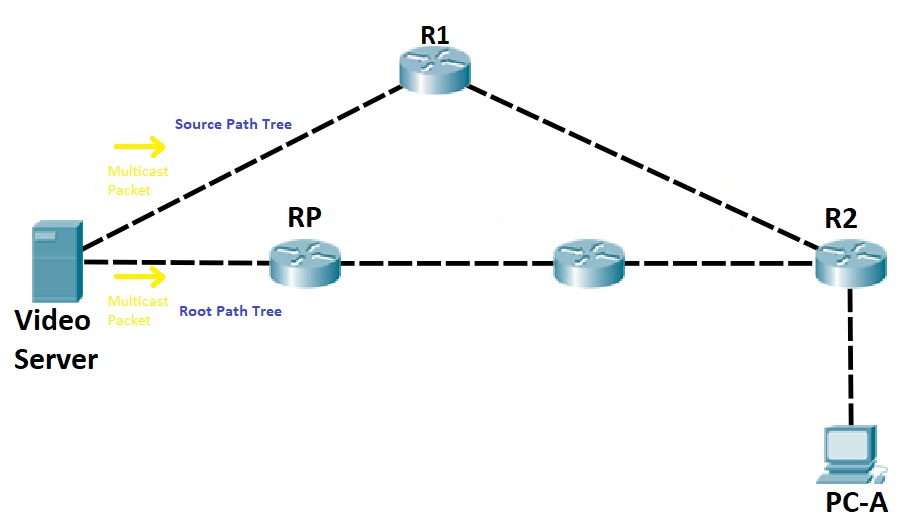Protocol Independent Multicast or PIM is a group of multicast routing protocols designed for specific network environments. To forward our IP multicast traffic, we need to use a multicast routing protocol. PIM Multicast is the only multicast routing protocol that Cisco IOS devices fully support. PIM can determine the path between the source and receivers using a particular unicast routing protocol.
Distribution Trees
Multicast routers specify the path that IP multicast packet takes through the network to reach the receivers by creating distribution trees. Source trees, also known as Shortest-Path Tree (SPT), and Shared Tree are the two basic types of multicast distribution trees.
Source Tree – A source tree is a multicast distribution tree in which the source is the root and branches extend down the network to the receivers. When this tree is formed, it takes the shortest path possible through the network from the source to the tree’s leaves; thus, it is also known as the Shortest-Path Tree (SPT).
Shared Tree – A shared tree is a multicast distribution tree in which the root is the Rendezvous Point (RP), rather than the source. As a result, a shared tree is sometimes referred to as an RP Tree (RPT). Regardless of the source address, multicast forwarding is according to the multicast group address to which the packets are addressed.
Wasted bandwidth is one drawback of Shared Tree since shared trees can allow multiple sources in an IP multicast group. It is also a potential security risk since unintended sources can send unwanted packets to receivers.

PIM Multicast Protocols and Messages
Currently, there are five PIM operating modes which are:
- PIM Dense Mode (PIM-DM)
- PIM Sparse Mode (PIM-SM)
- PIM Sparse Dense Mode
- PIM Source Specific Multicast (PIM-SSM)
- PIM Bidirectional Mode (Bidir-PIM)
PIM dense mode (PIM-DM) is a push model where we flood all interfaces with multicast packets except for routers that have no directly connected members or PIM neighbors.
On the other hand, PIM sparse mode (PIM-SM) is a pull model wherein we only send multicast traffic when requested. A Rendezvous Point or RP router serves as a point of contact for multicast senders and receivers.
Below we can see the different PIM Messages:
| Message Type | Destination | PIM Protocol |
| Hello | All PIM routers / 224.0.0.13 | PIM-SM, PIM-DM |
| Register | RP address / unicast | PIM-SM |
| Register stop | First hop router / unicast | PIM-SM |
| Join/prune | All PIM routers / 224.0.0.13 | PIM-SM |
| Bootstrap | All PIM routers / 224.0.0.13 | PIM-SM |
| Assert | All PIM routers / 224.0.0.13 | PIM-SM, PIM-DM |
| Candidate RP advertisement | Bootstrap router (BSR) address / unicast | PIM-SM |
| State refresh | All PIM routers / 224.0.0.13 | PIM-DM |
| DF election | All PIM routers / 224.0.0.13 |
Let’s also discuss other PIM Key Terms:
PIM Join Message – A request sent by a router towards the RP.
Internet Group Management Protocol (IGMP) – The protocol used by receivers to connect to multicast groups and begin receiving traffic from them.
Prune Message – Message sent to RP to inform other routers in the path that they can disable multicast traffic forwarding for a particular group.
RPF or Reverse Path Forwarding – PIM will only accept multicast packets on an interface that we use to reach the source. RPF failure is when we drop multicast packets that we receive on an interface that we don’t use to reach the source.
RPF Neighbor – The PIM neighbor on the RPF interface.
Upstream Router – A router where we receive multicast traffic from.
Downstream Router – A router where we forward multicast traffic to.
Download our Free CCNA Study Guide PDF for complete notes on all the CCNA 200-301 exam topics in one book.
We recommend the Cisco CCNA Gold Bootcamp as your main CCNA training course. It’s the highest rated Cisco course online with an average rating of 4.8 from over 30,000 public reviews and is the gold standard in CCNA training:
